Search results for: 'Stone to'
-
 Roman intaglio with lion
Roman intaglio with lionNice depiction of a lion on an orange glass paste from the Roman period.
Price: on request Roman intaglio with galley
Roman intaglio with galleyThe skillful work shows a Roman galley with rowers. It is a very rare depiction for an ancient glass paste.
Price: on request Roman intaglio with Eros
Roman intaglio with ErosThe skillful work shows the god Eros as a boy. Nice orange glass paste, imitating carnelian.
Price: on request Roman intaglio with goat
Roman intaglio with goatRoman jewellery insert made of light blue glass paste, imitating Nicolo. It shows a he-goat with a smaller animal in front of it.
Price: on request Roman intaglio with galley
Roman intaglio with galleyThe glass paste shows a Roman galley. It is a very rare depiction for an ancient ring insert.
Price: on request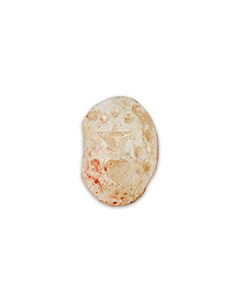 Roman intaglio with mixing vessel for wine
Roman intaglio with mixing vessel for wineThe Roman glass paste shows a tall vase surrounded by vine leaves. It is a mixing vessel for wine.
Price: on request Roman intaglio with griffin
Roman intaglio with griffinThe Roman decorative insert made of orange glass paste shows a mythical creature with a horse's body and an eagle's head, leaning on its front paws.
Price: on request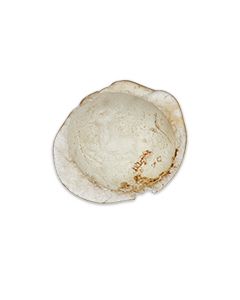 Roman intaglio with bull
Roman intaglio with bullThe Roman ring insert is made of colourless glass paste that imitates rock crystal. It depicts a jumping bull.
Price: on request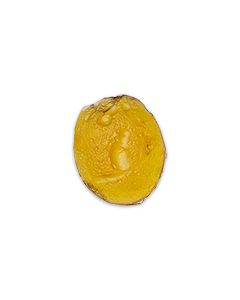 Roman intaglio with bird
Roman intaglio with birdThe glass paste shows a bird on a branch. From the Professor Brosch collection of ancient gems.
Price: on request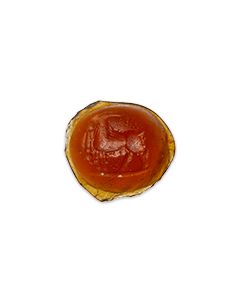 Roman intaglio with billy goat
Roman intaglio with billy goatThe Roman ring insert is made of orange glass paste that imitates carnelian. It depicts a horned quadruped.
Price: on request Roman intaglio inscribed DIOGENOY
Roman intaglio inscribed DIOGENOYThe gemstone made of red carnelian bears the inscription DIOGENOY. From the Roman period with original remains of the iron ring.
Price: on request Neolithic axe head
Neolithic axe headFinely crafted tool from the New Stone Age of Europe. A specimen of the thick butted type.
Price: on request Neolithic axe head
Neolithic axe headNicely crafted tool made of beige stone. From the New Stone Age of Europe. A specimen of the thick butted type with thin blade.
€245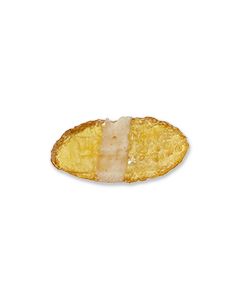 Roman intaglio
Roman intaglioRing insert made from beautiful, bright yellow glass paste. From the Professor Brosch collection of ancient gems.
Price: on request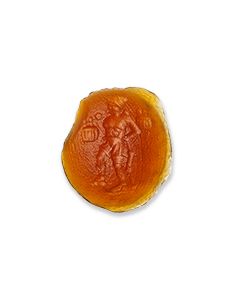 Roman intaglio with Odysseus as a beggar
Roman intaglio with Odysseus as a beggarThe roman intaglio shows an important scene from the Odyssey in which Odysseus returns home after his long journey. The hero is disguised as a beggar. He wears his pilos hat and is resting his weight on a stick.
Price: on request Roman intaglio with Ganymede and eagle
Roman intaglio with Ganymede and eagleThe dark glass paste symbolizes a famous love affair from ancient mythology. The sky father Zeus falls in love with the beautiful Ganymede, a Trojan king's son.
Price: on request Flint knife from Northern Germany
Flint knife from Northern GermanyFlat two-edged stone blade from the Dagger Period of Northern Europe.
Price: on request Neolithic axe head
Neolithic axe headThe strong blade was probably used for a battle axe. Crafted from grey rock. An artefact from the Neolithic Age of Europe.
€490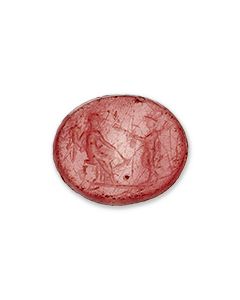 Roman intaglio with Hermes and Tyche
Roman intaglio with Hermes and TycheThe ancient intaglio from Roman times shows a scene between the two gods. From the Professor Brosch collection of engraved gems.
Price: on request Roman intaglio with hippocampus
Roman intaglio with hippocampusBeautiful depiction of the popular mythical creature from Greek and Roman art. The orange glass paste copies an engraved carnelian gem. From the Roman period.
Price: on request Neolithic axe head from Luetzow in Northern Germany
Neolithic axe head from Luetzow in Northern GermanyPolished axe made of beautiful brown flint. It was found more than 100 years ago near the town of Luetzow.
Price: on request Egyptian predynastic cosmetic palette
Egyptian predynastic cosmetic paletteHigh quality palette with two stylized bird heads. Characteristic for the Naqada II period. Circa 3500 to 3200 BC.
Price: on request Three neolithic arrowheads from Egypt
Three neolithic arrowheads from EgyptThe Stone Age points are beautifully crafted, with finely serrated edges. From a 100 year old museum collection.
Price: on request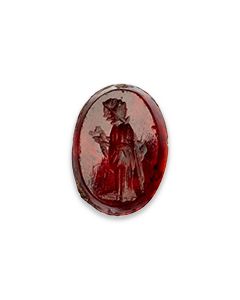 Roman intaglio of carnelian
Roman intaglio of carnelianThe gem stone from the Late Roman Imperial period is engraved in linear style. It shows a standing person in a cloak.
Price: on request Dark Roman glass paste with white band
Dark Roman glass paste with white bandThe Roman ring insert is in excellent condition. The small-format motif is not clearly identifiable, but it may show a head.
Price: on request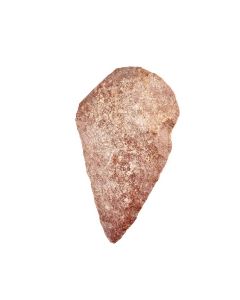 Paleolithic hand axe
Paleolithic hand axeThe universal tool of the older Stone age. It could be used as a borer or a cutter. Approx. 500,000 to 200,000 BC.
Price: on request Hand axe from Galilee
Hand axe from GalileeBig paleolithic hand axe. The universal stone age tool could be use as a borer or cutting tool. Around 500,000 to 200,000 BC.
Price: on request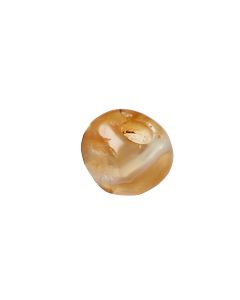 Sasanian stamp seal with winged animal
Sasanian stamp seal with winged animalWonderful stone, a cream-coloured agate. The engraved animal is probably a gazelle ready to jump. From the period of Sasanian rule in the Near East.
€190 Three neolithic arrowheads from Egypt
Three neolithic arrowheads from EgyptThe Stone Age points are beautifully crafted, with finely serrated edges. From a 100 year old museum collection.
Price: on request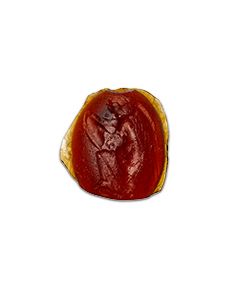 Roman intaglio with goddess of victory
Roman intaglio with goddess of victoryThe glass paste features a famous depiction of Victoria writing the names of victors in battle on a large shield. The motif reiterates a 1st century bronze statue.
Price: on request Roman intaglio with goddess of victory
Roman intaglio with goddess of victoryThe glass paste features Victoria writing the names of victors in battle on a large shield.
Price: on request Neolithic flint dagger from Denmark
Neolithic flint dagger from DenmarkDouble-edged blade and flat shaft made of beautiful flintstone. A status symbol from the transitional period between Late Neolithic and Early Bronze Age.
Price: on request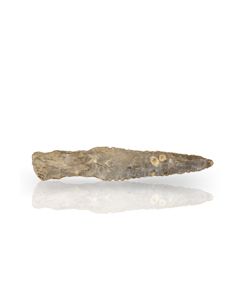 Neolithic flint dagger from Denmark
Neolithic flint dagger from DenmarkDouble-edged blade and flat shaft made of beautiful flintstone. A status symbol from the transitional period between Late Neolithic and Early Bronze Age.
€650 Neolithic flint dagger from Denmark
Neolithic flint dagger from DenmarkDouble-edged blade and flat shaft made of beautiful flintstone. A status symbol from the transitional period between Late Neolithic and Early Bronze Age.
€480 Neolithic dagger blade from Denmark
Neolithic dagger blade from DenmarkDouble-edged, pointed blade made of beautiful flint. The blade was for a dagger, the typical status symbol from the transitional period between Late Neolithic and Early Bronze Age.
€480 Neolithic dagger blade from Denmark
Neolithic dagger blade from DenmarkDouble-edged, pointed blade made of beautiful flint. The blade was for a dagger, the typical status symbol from the transitional period between Late Neolithic and Early Bronze Age.
€470

